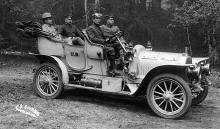The automotive Brass Era is the first period of automotive
manufacturing, named for the prominent brass fittings
used during this time for such things as lights and
radiators. It extends from the first commercial
automobiles marketed in the 1890s until about
World War I. The term "Brass Era automobile" is a
retronym for "horseless carriage," the original name for such
vehicles, which is still in use today. The Brass Era closely followed
the
Veteran Era.

A
Royal Motor Company Tourist model US Army vehicle, circa 1906.
The vehicle was the conveyance of General
Frederick Funston (leftmost figure in the back seat).
Within the 15 years that make up this era, the various experimental
designs and alternate power systems would be marginalized. Although the
modern
touring car had been invented earlier, it was not until Panhard
et Levassor's
Système Panhard was widely licensed and adopted that
recognizable and standardized automobiles were created. This system
specified
front-engined,
rear-wheel drive
internal combustion engined cars with a sliding gear
transmission. Traditional
coach-style vehicles were rapidly abandoned, and buckboard
runabouts lost favor with the introduction of tonneaus
and other less-expensive touring bodies.
Throughout this era, development of
automotive technology was rapid, due in part to hundreds of small
manufacturers competing to gain the world's attention. Key developments
included the electric
ignition system (by
dynamotor on the
Arnold in 1898,
though
Robert Bosch, 1903, tends to get the credit),
independent suspension (actually conceived by Bollée in 1873),
and four-wheel brakes
(by the
Arrol-Johnston Company of
Scotland in 1909).
Leaf springs were widely used for
suspension, though many other systems were still in use, with angle steel
taking over from armored wood as the
frame material of choice.
Transmissions and throttle controls were widely adopted, allowing a
variety of cruising speeds, though vehicles generally still had discrete
speed settings, rather than the infinitely variable system familiar in
cars of later eras. Safety glass also made its debut, patented by
John Wood in England in 1905.
(It would not become standard equipment until 1926, on a
Rickenbacker.)
Between 1907 and 1912 in the United States, the
high-wheel motor buggy (resembling the horse buggy of before 1900)
was in its heyday, with over seventy-five makers including
Holsman (Chicago),
IHC (Chicago), and
Sears (which sold via catalog); the high-wheeler would be killed by
the Model T.
In 1912, Hupp
(in the U.S., supplied by
Hale & Irwin) and
BSA (in the UK) pioneered the use of all-steel bodies,
joined in 1914 by Dodge
(who produced Model T bodies).
While it would be another two decades before all-steel bodies would be
standard, the change would mean improved supplies of superior-quality
wood for
furniture makers.
